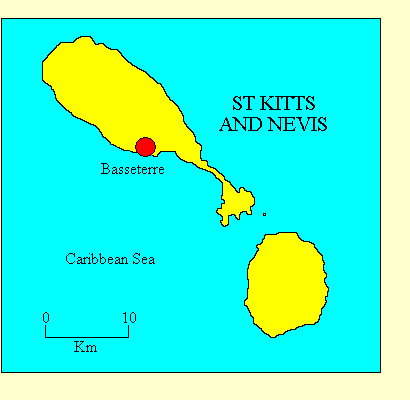

FEDERATION OF
ST KITTS
AND NEVIS
• Official name: Federation of Saint Kitts and Nevis (the older name St Christopher and Nevis is sometimes used)
• Location: Caribbean
• International organisations: African, Caribbean and Pacific Group of States, Commonwealth of Nations, Organisation of
American States, United Nations, World Trade Organisation
• Borders: None
• Coastline: Caribbean Sea
• Land area: 261 Km2
• Population: 43,000
• Annual GDP (PPP) per capita: US$15,200 (2009 CIA estimate). World ranking: 57
• Ethnicity: More than 90% of the population are of African descent. There are small
European and Lebanese minorities.
• Languages: English is the official language and is generally understood. Most of the
population speak a local creole.
• Religion: Over 70% of the population are Christian, the large majority Protestant.
• Form of government: Constitutional monarchy and parliamentary democracy. St Kitts and Nevis is
divided into eleven parishes.
• Capital: Basseterre
• Constitution: The
Constitution of St Kitts and Nevis came into effect on 19 September 1983.
• Head of state: Queen Elizabeth II, Queen of St Kitts and Nevis. The Queen came to the British
throne on 6 February 1952, and has held the title Queen of St Kitts and Nevis since 19 September 1983.
The Queen's functions in St Kitts and Nevis are excercised by a Governor-General, appointed by the
Queen on the advice of the Prime Minister. The current Governor-General,
Sir Cuthbert Sebastian, took office on 1 January 1996.

• Head of government: The Prime Minister, appointed by the Governor-General. The Prime Minister is the
leader of the largest party in the legislature and is accountable to it.
• Legislature: St Kitts and Nevis has a unicameral legislature, the
National Assembly, which has 14 members, 11 elected for five-year terms from single-member constituencies, and
three appointed members.
• Electoral authority: none known
• Freedom House 2009 rating: Political Rights 1, Civil Liberties 1
Political history
St Kitts and Nevis were discovered and named (as San Cristobal and Nuestra Senora de las Nieves) by
Columbus in 1493. The islands were colonised by the British in 1623. St Kitts changed hands between the
British and the French before being finally ceded to Britain in 1713. They were incorporated into the British
colony of the Leeward Islands in 1871, and in 1958 became part of the self-governing West Indies Federation. When
the federation broke up they became a separate colony of St Christopher-Nevis-Anguilla, but Anguilla seceded in 1971.
St Kitts and Nevis became fully indepenent in September 1983.
St Kitts and Nevis has been dominated since independence by the
St Kitts and Nevis Labour Party, a social democratic party despite its radical rhetoric, led first by
Kennedy Simmonds and since 1995 by Denzil Douglas. Its main opposition is
the moderate People's Action Movement. Many people on the island
of Nevis wish to secede from the federation. The Concerned Citizens' Movement favours independence while the
Nevis Reformation Party opposes it. At the 2010 election, Labour was returned to office with a slightly reduced majority.
Updated January 2010
|

